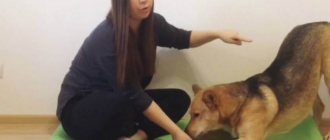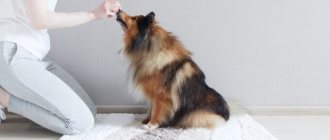Among Yorkie owners, there is an opinion that their pets do not need training. After all, they are smart in themselves, but due to their small size they do not pose a danger to others. This is not true; any dog, even the smallest and most harmless one, must be raised correctly. This will save both the owner of the animal and the dog itself from a lot of troubles and, perhaps, even save the Yorkie’s life in a critical situation someday.
The need for education at home
Even if a Yorkie is trained by a professional dog trainer, the puppy still needs early training and socialization. Proper home education will make the training process easier. If you are late with this, then as a result the Yorkshire may develop negative character traits and develop undesirable behavior. Many dog owners confuse education with training, believing that both training processes mean the same thing.
In fact, training is teaching a dog special commands, and education is the formation of behavior that is desirable for the owner of the animal in the process of everyday communication with him. Unlike training, raising a dog is not limited to a specific course. It begins from the first day a Yorkie appears in the house and continues throughout its subsequent life.
In the process of raising a dog at home, the relationship between a Yorkie and its owners is established, as well as the dog’s basic behavior patterns in various conditions.
Basic recommendations
When starting to raise, and, later, train a Yorkie, you need to be guided by the following recommendations:
- It is necessary to adhere to the principle of consistency. First teach your pet simpler commands, and then move on to more complex ones.
- Any address to the puppy and any command must be supported by a nickname at the beginning of training.
- Commands must be spoken in a calm voice. Exceptions are prohibiting commands “No!” and “Fu!”, which should be pronounced with a threatening intonation.
- It is unacceptable to distort the names of commands during training, for example, saying “Stop!” or “Sit down!” instead of “Stop!”
- You cannot raise a dog only with the help of prohibitions and punishments or, conversely, only with the use of encouragement. These methods should be combined with each other and used as needed.
- During training, you should not undeservedly punish your pet or yell at it too much. This will lead to the fact that the Yorkie will lose all desire to learn.
- When walking with your pet, you should not allow him to follow commands given by strangers.
If a dog refuses to follow commands, the owner must force it to do what is required.
Teaching your baby a nickname
The most basic thing is to teach the puppy to respond to the chosen nickname. In order not to complicate life for both of you, choose a short and sonorous name for your pet. Call your puppy by name whenever possible. Pay attention to intonation. Harsh and harsh treatment is not acceptable. The baby should obey you, and not be afraid. In order not to confuse the dog, you should not correct the nickname with affectionate and diminutive variants. When playing, pet the puppy and also call him by name.
At the first positive results (you called the puppy and he came), do not forget to praise and reward the pet with treats. Go into another room and call the puppy again. If he runs up, praise him.
All family members can participate in training. You can sit in a circle and call your baby one by one. To ensure positive dynamics, don’t skimp on affection and treats. Some breeders are against joint training, believing that a dog should have one owner. I won't argue. Everyone has the right to choose how to raise their dog.
Yorkie puppies quickly begin to respond to their name. 1-2 days is enough. When the first lesson is learned, you can move on to more complex commands.
What will you need for classes?
For training, you will need appropriate equipment for the dog, as well as some necessary equipment, such as:
- Reliable collar.
- The leash is short (about 1.5 meters).
- The leash is long (from 5 to 10 meters).
- Harness.
- Treat bag.
- Delicacy.
As a treat, it is recommended to use your Yorkie's favorite food, which does not get your hands dirty and does not take up much space in the bag.
It is best to conduct classes with your pet in a specially equipped training area.
The dog owner should dress appropriately for the weather conditions. Clothing should not be too heavy or restrict movement.
Four to five months
Continue to practice the completed commands with your pet so that they can be carried out unquestioningly. You can also start visiting special dog training grounds to get some physical exercise. You can run with your dog a little, teaching him to jump over small barriers. But for now, avoid your puppy interacting with other dogs.
Begin to cultivate perseverance and perseverance in your Yorkshire Terrier - he should be able to restrain himself at the sight of food or natural food placed nearby.
How to start training?
The beginning of training is inseparable from the education process.
The puppy begins to learn the first commands at the age of 1.5 - 2 months, while still in the breeder’s house.
Once in a new home, a Yorkie may forget what was taught before, so the owner will have to re-teach it commands. They begin systematic training sessions later - not earlier than the puppy is 4 months old. To prevent the start of training from becoming stressful for your Yorkie, it is advisable to conduct the first classes at home.
For the first outdoor lesson, it is recommended to choose a clear and, if possible, warm, but not hot day.
Basic commands
The Yorkie does not need special protective training, and most tricks do not need to be taught to him. But he must know the basic commands and follow them.
Nickname
Given to a Yorkie on the first day of his arrival in the house. It is unacceptable to distort the name or call the dog by different names.
"Ugh!"
It is not a substitute for the “No!” command. It does not mean a prohibition to do anything, but is an order not to pick up food from the ground or take food from strangers. This command must be used carefully and only when the dog is trying to grab a suspicious thing in its mouth or has already managed to do so.
"It is forbidden!"
Prohibition to continue any actions. Like "Ugh!" this command should be pronounced with a threatening intonation, but without raising the voice.
"Place!"
In order for the puppy to always go to his bed on command, it is necessary to take him there from the first day, as soon as he falls asleep. At the same time, when laying your Yorkie down, you need to pet him and say in a calm tone: “Place!” If the dog wants to leave, then you need to put it back on the bed and repeat the command more strictly.
"To me!"
In order to teach your pet this command, you need to show him a treat, and then give the command “Come to me!” When your Yorkie runs up, you need to reward him with praise and treats.
"Sit!"
You need to take your Yorkie on a leash, then say “Sit!”, while simultaneously pulling the leash up. And after following the command, be sure to praise your pet and give him a treat.
"Lie!"
To teach your Yorkie this command, you need to show him a treat, then lower your hand down and extend it slightly forward. At the moment when the dog begins to reach for a treat, you should give a command and after it is completed, give the pet the treat.
"Near"!
After pronouncing the command, you need to pull the dog by the leash and make it walk next to the owner’s left leg. When trying to run ahead or fall behind, you need to pull the leash and repeat in a stern voice: “Near!”
When teaching the commands “Sit!” or “Here!”, jerking the leash should not cause pain or discomfort to the pet.
How to stop barking
Excessive barking from a pet can make life very difficult for its owners.
To prevent such a problem from arising, you need to wean your dog from barking unnecessarily from an early age.
The simplest solution is to distract your Yorkie by playing and barking at other animals or people.
To do this, you need to show the dog a toy, but not give it away right away, because otherwise the Yorkie may decide that the owner is rewarding him with a game for barking loudly. If your pet is barking for no reason, you can spray water on it: this will make the dog shut up.
As a punishment for barking over trifles, it is best to use ignoring: forcing the Yorkie to shut up, then simply not paying attention to him for a while. If the dog already knows the commands “No!” and “Place!”, then you can give her the first of them first, and after a short time - the second.
When training a dog to bark, it is unacceptable to use physical punishment. You can scold your pet or spray it with water from a spray bottle, but you cannot shout or hit it.
How to train an adult dog to behave outdoors?
It is much easier to accustom a small puppy to rules of behavior or commands. But it is also possible to train an adult dog. In order for your Yorkie to behave well outside, it is important to let him understand that only the owner controls the walk.
Often dogs begin to pull the owner to the side or run quickly.
To prevent this from happening, every time the dog starts to pull on the leash, you need to stop, that is, stop moving altogether..
There is no need to drag the dog towards you, just hold the leash tightly so that the dog cannot move. You need to walk at a calm, measured pace.
NOTE!
If the owner starts running, the dog will follow him and run even faster. At first, you shouldn’t take your dog for long walks - this way the dog will quickly get bored and tired.
Gradually, the walking time can be increased . In about a month, the Yorkie will understand how to behave on the street and there will be no problems with him.
Peculiarities
When training a Yorkie, you must not forget about the breed characteristics of these dogs.
Yorkies, like true terriers, can be willful and stubborn.
In this case, the main task of the owner is to force the pet to carry out the command.
Due to their playful and restless nature, they can be constantly distracted by something during classes. It is necessary to ensure that the dog's interest during the training process is focused only on the owner and the learning process itself. In order to interest your Yorkie, you need to reward the dog more often with treats or games, and punish less.
Why is Yorkie training necessary?
Training a Yorkie will make life easier for both owner and pet. There is an opinion that small pets are very stupid due to the fact that their brains are smaller than those of adult dogs, and they do not perceive or remember commands. But this is not at all true; it is enough to correlate the proportions of the brain to the dog’s body. But precisely because the owners treat their pets so disrespectfully, they are often spoiled and ill-mannered. Yorkies are most often simply coddled and treated like toys; this would not occur to owners of large breed dogs. Thanks to this, the opinion about the stupidity of Yorkshire terriers exists among the people, but it is not substantiated by anything.
A Yorkie must obey his owner when walking
Most common mistakes
When training and teaching dogs, owners sometimes make mistakes, the most common of which are:
- Humanizing the dog. For example, when the owner talks to the pet, explaining in detail how to carry out the command.
- Training is carried out without taking into account the individual characteristics of the pet.
- Lack of consistency in the training process.
- Classes are conducted without taking into account the surrounding environment. For example, a dog is trained in a place where there are a lot of distractions.
- All classes take place in the same sequence. This develops a certain behavioral stereotype in the dog.
- Retraining. The dog simply gets tired of following the same commands for too long.
- Incorrect sequence of actions. For example, the owner first pulls the leash, and then gives the command “Near!”
- The command is pronounced with incorrect intonation. For example, the owner gives all commands in a threatening tone, although the dog does everything correctly.
- Repeating the command several times. The owner repeats it several times and the dog gets used to following the command only after it is said again.
- Unwanted command connections. In this case, one command precedes another, and the same one. And as a result, for example, having heard “Sit”, the dog then lies down without a command.










